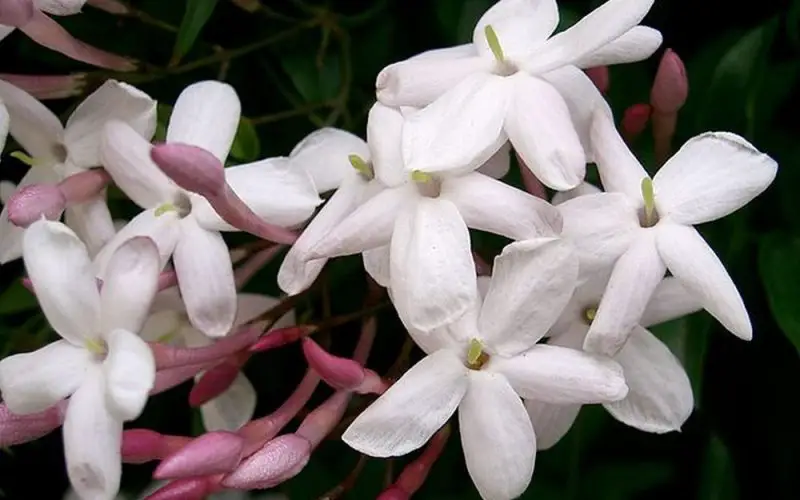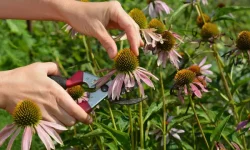Star jasmine is a beautiful climbing vine valued for its evergreen leaves and fragrant white flowers. Many gardeners grow it to cover fences, walls, or trellises for natural green privacy. Understanding how fast it grows helps plan garden designs and set realistic expectations for coverage.
This plant is not among the fastest climbers, but under good conditions, it can establish quickly. Once settled, it delivers steady growth each season. With the right care, star jasmine can provide lush greenery that enhances both outdoor beauty and shade.
Table of Contents
ToggleUnderstanding Star Jasmine Growth

Star jasmine is a twining vine that develops steadily once established. In its first year, the plant invests most of its energy in root growth. Shoots may appear shorter and less vigorous during this stage, which is perfectly normal. The root system builds strength to support the heavy climbing growth that will follow. Patience is important because the early phase lays the foundation for future coverage.
By the second and third years, star jasmine begins to show stronger growth above ground. Vines can extend between one and two feet each season if conditions are favorable. With proper sunlight, fertile soil, and enough water, the plant quickly fills available space. Mature plants can reach heights of 15 to 20 feet when trained on walls or trellises. Their dense foliage creates a uniform layer of greenery that remains attractive throughout the growing months.
The growth pattern of star jasmine is not aggressive compared with faster climbers like wisteria. Instead, it develops at a moderate pace that is easier to manage. In warm climates, growth continues almost year-round, though it is most active in spring and summer. In cooler climates, growth slows during fall and winter but restarts strongly with rising temperatures. This steady habit makes star jasmine reliable for gardeners seeking long-term coverage without uncontrolled spread.
Factors That Influence Growth
Climate Conditions
Climate is one of the strongest influences on star jasmine growth. This plant thrives in warm and temperate zones, especially USDA zones 8 to 11. Long summers and mild winters allow vines to grow almost continuously. In these regions, the plant achieves fuller coverage faster and flowers more abundantly. Cold temperatures, however, can slow development or even damage foliage. Gardeners in cooler climates often see slower growth during fall and winter.
Frost protection is essential when temperatures drop below freezing. Covering plants or moving container specimens indoors helps prevent damage. In colder regions, the growth season is shorter, meaning vines take longer to reach maturity. By contrast, tropical and subtropical climates encourage nearly year-round growth. Understanding the local climate is crucial for predicting how fast star jasmine will grow. Proper care in relation to weather conditions ensures steady progress.
Soil Quality
Soil quality has a direct impact on root health and vine strength. Star jasmine prefers loamy soil that drains well but also holds enough moisture. Heavy clay soils often retain too much water, which can lead to root rot and slow growth. Sandy soils, on the other hand, may drain too quickly, leaving roots deprived of moisture. Amending the soil with organic matter is the best way to create balance.
Good soil not only improves drainage but also increases nutrient availability. Adding compost or aged manure enriches the ground and feeds roots gradually. The ideal pH range for star jasmine is slightly acidic to neutral. Regularly testing soil ensures conditions remain optimal for development. Healthy soil provides the foundation for vigorous and consistent growth. Without it, even the best watering and fertilizing routines will not deliver strong results.
Sunlight Exposure
Sunlight is another critical factor that influences star jasmine growth. This plant performs best in full sun, receiving at least six hours of direct light daily. Strong sunlight fuels photosynthesis, which directly supports vine extension and flower production. Without enough light, the plant may produce fewer leaves and appear thin. Growth slows significantly in deep shade, and blooms may be limited or absent.
In hot climates, partial shade during the hottest hours can prevent stress. This balance allows plants to receive adequate energy without burning. Star jasmine grown on walls facing south or west often thrives due to long sun exposure. Choosing the right planting site is important for rapid establishment. Adequate sunlight ensures star jasmine grows vigorously and covers spaces with dense foliage.
Water Availability
Watering habits play a big role in how fast star jasmine develops. Young plants require consistent moisture to establish roots. The soil should remain evenly moist but never waterlogged. Too much water reduces oxygen in the soil, damaging roots. Too little water causes stress, leading to leaf drop and stunted growth. Striking the right balance is essential.
As the plant matures, it becomes more tolerant of short dry periods. However, regular watering during hot summers keeps vines lush and healthy. Mulching around the base helps retain soil moisture and regulate temperature. Adjusting watering based on climate and season ensures plants grow at their best. Proper hydration encourages steady development and quicker wall coverage.
Fertilization Practices
Fertilizer directly affects the strength and speed of star jasmine growth. Balanced fertilizers containing nitrogen, phosphorus, and potassium encourage both foliage and flower production. Nitrogen supports leaf growth, while phosphorus boosts root development. Potassium enhances overall vigor and resistance to stress. Without nutrients, growth may slow, and foliage can lose its rich green color.
Applying fertilizer in spring jump-starts the growth season. A second feeding in summer helps sustain energy for continuous climbing. Slow-release formulas provide steady nutrition, while organic compost improves soil health long-term. Over-fertilizing should be avoided, as it can harm roots and reduce flowering. Consistent, moderate fertilization ensures vines remain vigorous and capable of fast coverage. Healthy nutrition is one of the best ways to influence star jasmine growth speed.
Ideal Climate for Star Jasmine
Star jasmine thrives best in warm and temperate climates where it can receive consistent sunshine and moderate humidity. This plant grows vigorously in regions with mild winters and long, warm summers. It is well suited for USDA hardiness zones 8 through 10, where freezing temperatures are rare or short-lived. In these areas, the vine remains evergreen, offering year-round greenery and fragrance. Cooler climates may limit its growth, but with proper protection during frosty nights, star jasmine can still survive and flourish.
Temperature plays a crucial role in determining how quickly this plant establishes itself. Star jasmine prefers daytime temperatures between 65 and 85 degrees Fahrenheit, which support healthy foliage and rapid climbing. Although it tolerates brief cold snaps, extended periods below 20 degrees Fahrenheit can damage or even kill the plant. Gardeners in colder regions often grow it in containers, which allows them to move the plant indoors during harsh winters. This adaptability makes star jasmine an attractive option for different environments when proper care is provided.
Humidity and rainfall also influence growth. Star jasmine enjoys slightly moist air and benefits from regular watering during dry spells. However, overly wet conditions and poor drainage can hinder its development and cause root issues. In coastal regions, the plant often thrives due to mild temperatures and balanced humidity. Meanwhile, in drier inland areas, supplemental watering is essential to maintain lush growth. By understanding the ideal climate conditions, gardeners can provide the right balance of warmth, sun, and moisture to ensure this vine grows at its fastest and fullest potential.
Sunlight Needs for Vigorous Growth
Star jasmine thrives best when it receives plenty of sunlight, which fuels its growth and flower production. This plant prefers full sun for at least six hours a day, as light directly impacts the vigor of its vines and the abundance of blossoms. When exposed to bright conditions, star jasmine produces denser foliage and more fragrant flowers, creating the lush green walls that many gardeners admire. Without sufficient light, its growth may appear thin, and flowering will be significantly reduced.
While star jasmine loves the sun, it can also adapt to partial shade, especially in hotter regions. Afternoon shade is beneficial in areas with scorching summers, as it helps protect the plant from leaf scorch and excessive stress. In these climates, placing the plant where it enjoys morning sun and afternoon protection ensures healthy development without sacrificing flowering potential. This balance allows the plant to flourish while maintaining resilience against extreme temperatures.
Gardeners growing star jasmine indoors or in shaded landscapes should consider strategic placement to maximize available light. South-facing walls, trellises, or fences often provide ideal exposure. If growing in containers, plants can be moved seasonally to capture better sunlight conditions. Providing adequate light is one of the most effective ways to encourage robust growth and continuous blooms. With the right balance of sun and shade, star jasmine becomes a vigorous, reliable climber that adds both beauty and fragrance to gardens year after year.
Soil Requirements and Preparation
Star jasmine thrives best when planted in well-draining, fertile soil that retains some moisture without becoming waterlogged. Heavy clay soils that trap water can cause root rot, while sandy soils may dry out too quickly. To create an ideal growing environment, gardeners should aim for a loamy soil that balances aeration, drainage, and organic content. A pH level between 6.0 and 7.5 is generally considered perfect, as it allows the plant to absorb nutrients efficiently.
Before planting, it is beneficial to enrich the soil with organic matter such as compost, leaf mold, or well-rotted manure. These amendments improve soil structure, provide slow-release nutrients, and help regulate moisture. If the soil is heavy clay, mixing in coarse sand or perlite enhances drainage, while sandy soil can be improved with additional compost to boost water retention. Proper preparation ensures that the roots establish quickly and develop a strong foundation for long-term growth.
In addition to soil improvement, preparing a wide planting hole is key to success. Dig a hole twice as wide as the root ball but no deeper, ensuring the roots spread easily without being compacted. Mulching around the base with organic mulch, such as shredded bark or straw, helps maintain soil moisture and reduces weeds. With careful attention to soil quality and preparation, star jasmine will grow vigorously, producing healthy foliage and abundant blooms.
Watering Strategies for Healthy Development
Star jasmine thrives best when it receives consistent moisture, especially during its active growing months in spring and summer. Deep watering is more effective than frequent light watering, as it allows the roots to grow deeper into the soil. A thorough soak once or twice a week is usually enough for established plants, while young or newly planted vines may need additional watering until their root systems are well developed. Ensuring that water reaches the root zone without pooling on the surface is key to preventing shallow growth.
Soil drainage plays a critical role in successful watering practices. Although star jasmine enjoys moisture, it cannot tolerate standing water or waterlogged conditions. To strike the right balance, check the top few inches of soil before watering. If it feels dry, it is time to water again. Adding organic mulch around the base of the plant helps retain soil moisture, reduce evaporation, and maintain a stable temperature for the roots. Mulching also decreases the frequency of watering during hot spells, making care easier.
Seasonal adjustments are essential for proper watering strategies. During hot and dry summers, star jasmine requires more frequent hydration, especially if grown in containers. In contrast, watering should be reduced in cooler months to prevent root rot. Overwatering in winter is one of the most common mistakes gardeners make, so allowing the soil to dry slightly between waterings is important. By paying attention to seasonal shifts and soil moisture levels, you can encourage robust root development and keep your star jasmine healthy year-round.
Fertilization Techniques for Maximum Growth
Star jasmine benefits greatly from consistent feeding, which fuels both foliage density and blooming potential. The plant is not heavy-feeding but responds best to balanced nutrition applied at the right times. A slow-release granular fertilizer with equal proportions of nitrogen, phosphorus, and potassium works well in spring. This provides a steady supply of nutrients during the main growing season. For container-grown plants, water-soluble fertilizers every four to six weeks help maintain vigor.
During peak summer, star jasmine appreciates a light boost with a fertilizer slightly higher in phosphorus to encourage blooming. Avoid excessive nitrogen, as it can cause lush leaves at the expense of flowers. Gardeners in nutrient-poor soils should enrich with compost or organic matter before fertilizing to improve absorption. Always water the soil thoroughly after applying fertilizer to prevent root burn and help nutrients reach the root zone effectively.
In fall, reduce feeding gradually to allow the plant to harden off before cooler weather. Fertilizing too late in the season may encourage tender growth that is easily damaged by frost. Organic options such as fish emulsion or compost tea are excellent choices for those preferring sustainable methods. With a careful fertilization routine, star jasmine develops glossy foliage and produces an abundance of fragrant blooms year after year.
Training Star Jasmine for Green Walls
Training star jasmine onto a vertical surface transforms it into a stunning green wall. The plant naturally climbs using twining stems, but it needs initial guidance to establish coverage. Start by securing young vines to trellises, wires, or fences with soft ties. Regularly check attachments to prevent damage as stems thicken over time. Encouraging horizontal growth early helps distribute foliage evenly and creates a fuller wall effect.
As the plant matures, guide new shoots toward gaps in coverage to achieve uniform density. In cases where natural twining is insufficient, gently weaving stems through supports ensures stronger attachment. Patience is essential, as star jasmine can take a year or more to completely cover a structure. Strategic training also improves airflow, reducing the risk of fungal problems in dense growth.
Once established, star jasmine requires minimal intervention to stay in place. Occasional redirection of vigorous shoots helps maintain neat lines and prevents overgrowth. Gardeners can combine training with selective pruning to enhance coverage and shape. With consistent guidance, the plant becomes a lush vertical carpet, providing greenery, fragrance, and privacy. Over time, trained star jasmine evolves into a living architectural feature that enriches any landscape.
Pruning Methods for Denser Coverage
Pruning is essential for controlling star jasmine’s growth and encouraging denser foliage. Without regular trimming, the plant may become leggy and sparse, reducing its visual appeal. Begin pruning in early spring, just before the active growth phase. Removing weak or tangled stems stimulates stronger new shoots. Cutting back long runners also redirects energy into lateral branching, resulting in thicker coverage across walls or trellises.
During summer, light maintenance pruning keeps growth in check and prevents the vine from overtaking nearby plants or structures. Focus on thinning crowded areas to improve airflow, which helps minimize pests and diseases. If the plant is grown in containers, trimming roots and foliage together every few years can rejuvenate overall health. Always use sharp, clean tools to avoid damaging stems.
In late fall, after flowering slows, perform a shaping prune to maintain form through the dormant period. This ensures the plant remains compact and ready for vigorous growth the following spring. Avoid cutting too severely during this time, as it may stress the plant. With consistent seasonal pruning, star jasmine develops a fuller appearance, more blossoms, and a healthier framework. Properly pruned vines reward gardeners with dense, fragrant walls that stay vibrant year-round.
Seasonal Growth Patterns
Spring Growth
In spring, star jasmine awakens from its dormant winter phase and begins active growth. New shoots appear rapidly, and glossy green leaves expand to form a fresh layer of foliage. This season also brings the first wave of flowers, filling the air with their rich fragrance. Gardeners should provide consistent watering and balanced fertilization during this time, as plants use significant energy to push new growth and blooms.
Spring growth often sets the pace for the rest of the year. If plants receive enough sunlight and nutrients, they establish strong shoots that later climb and cover walls more effectively. Early pruning of weak or crossing stems in spring also ensures the plant directs energy into healthy branches. Managing growth in this season creates the foundation for lush summer coverage.
Summer Growth
Summer is the peak growing season for star jasmine. The plant thrives in warm temperatures and long days of sunlight, producing vigorous vines and abundant blossoms. Regular watering is crucial, as the combination of heat and rapid growth can quickly dry the soil. Providing a slow-release fertilizer at the start of summer also helps maintain continuous energy for both foliage and flowers.
During summer, star jasmine tends to extend its climbing vines aggressively. Gardeners should guide these shoots onto trellises, fences, or walls to ensure even coverage. Occasional trimming of excess or tangled growth prevents overcrowding and encourages denser branching. Summer care is essential for shaping the plant into an attractive green wall while maximizing its decorative value.
Autumn and Winter Adjustments
As autumn arrives, the growth of star jasmine begins to slow down. The cooler temperatures and shorter days signal the plant to reduce its energy use. While flowering subsides, the vines focus on conserving strength in their root systems. This shift makes autumn an excellent time for light pruning, removing old or damaged stems to prepare for the following spring. Fertilizer should be reduced to avoid forcing new growth that might struggle with colder weather ahead.
Winter brings a period of relative dormancy. In warmer regions, star jasmine retains much of its foliage, though growth nearly halts. In colder climates, some leaves may drop, but the plant usually survives if protected from frost. Gardeners should minimize watering during winter, providing only enough moisture to prevent roots from drying out. Mulching around the base helps insulate against cold. By respecting the plant’s natural rest cycle, gardeners set the stage for renewed vitality and another season of vigorous growth when spring returns.
Container vs Ground Growth
Growing Star Jasmine in Containers
Growing Star Jasmine in containers is a popular choice for gardeners with limited space, patios, or balconies. Containers allow you to move the plant easily to chase sunlight or protect it from harsh weather. They also help manage soil quality and prevent roots from spreading uncontrollably. This makes them an excellent option for renters or small garden owners. With the right potting mix and regular fertilization, container-grown Star Jasmine can thrive and deliver lush greenery and abundant blooms in a compact setting.
However, there are some drawbacks to container growth. The plant’s root system becomes restricted, which can limit its overall size and vigor compared to ground-planted vines. Containers also dry out faster, meaning the plant requires more frequent watering, especially in summer. If not monitored carefully, nutrient depletion can weaken the plant over time. Additionally, large containers may be heavy and hard to move, reducing flexibility once the plant matures. Despite these challenges, containers remain a practical and versatile choice when managed properly.
Growing Star Jasmine in the Ground
Planting Star Jasmine directly in the ground provides the plant with more freedom to grow and spread naturally. The roots have access to deeper soil layers, which supports stronger growth, larger size, and more vigorous flowering. Ground planting also reduces the need for frequent watering since the soil retains moisture better than pots. This method works especially well for covering fences, trellises, and garden walls, creating a lush, long-lasting landscape feature with minimal maintenance once established.
On the other hand, growing Star Jasmine in the ground has its challenges. It can become invasive if left unchecked, as its strong root system and rapid growth may spread beyond intended areas. Unlike containers, you cannot easily move the plant if conditions change, making location selection critical. Soil quality is another factor—poor drainage can lead to root rot. Additionally, pruning is necessary to prevent overgrowth and maintain shape. While ground planting offers the greatest potential for lush coverage, it demands careful planning and long-term commitment.
Landscaping Ideas with Star Jasmine
Star jasmine is a versatile plant that offers many creative possibilities in landscape design. One of the most popular ways to use it is as a climbing vine on trellises, arbors, or pergolas. Its glossy leaves and fragrant white flowers create a lush, romantic look, turning any structure into a focal point. When trained properly, the plant quickly covers bare walls or fences, providing a natural green screen that adds both beauty and privacy to your garden.
Another attractive use is as a ground cover. In open spaces or under trees, star jasmine forms a dense carpet of greenery with seasonal bursts of star-shaped blooms. This option works well in both formal gardens and more relaxed settings, where the plant helps suppress weeds and stabilizes the soil. Because it tolerates pruning, you can maintain it at different heights and shapes, adjusting to the design you prefer.
You can also grow star jasmine in containers, making it an excellent choice for patios and balconies. With a supportive frame, it climbs vertically without taking much floor space, perfect for smaller urban gardens. Its fragrant flowers fill the air in the evening, creating a refreshing atmosphere. Whether as a climber, ground cover, or potted accent, star jasmine blends seamlessly with roses, hydrangeas, and evergreen shrubs, enhancing garden texture and seasonal interest.
Common Problems That Slow Growth
Poor Soil Conditions
Star jasmine struggles to grow vigorously when the soil is either too compacted or poorly draining. This vine prefers soil that is loose, fertile, and rich in organic matter, allowing roots to spread easily. When the ground becomes waterlogged, roots may suffocate, leading to stunted growth and weak foliage. On the other hand, overly sandy soil drains too quickly and fails to retain essential nutrients and moisture. Both extremes can slow development and prevent the plant from establishing a strong root system. Gardeners often notice pale or yellowing leaves as an early sign of soil stress. To overcome this problem, amending the soil with compost or well-rotted organic material can create the right balance of drainage and fertility. Mulching around the base also helps retain moisture while preventing the soil from compacting. By improving the soil environment, you create the foundation for steady growth and healthy flowering that star jasmine is naturally capable of producing.
Watering Mistakes
Improper watering practices are another common cause of slow growth in star jasmine. Too much water creates conditions for root rot, which damages the plant’s ability to absorb nutrients. On the other hand, letting the soil dry out completely between waterings stresses the vine, leading to curled leaves, reduced flowering, and sluggish growth. Consistency is the key to keeping this plant thriving. Star jasmine prefers evenly moist soil, especially during its active growing season in spring and summer. Allowing the top layer to dry slightly before watering again provides a good balance, helping roots breathe while staying hydrated. Overhead watering may also invite fungal problems, so directing water at the base is always better. Establishing a routine that suits the climate and season ensures the vine gets just enough moisture without extremes. When the watering approach is corrected, gardeners often see stronger shoots and healthier foliage, proving how vital hydration balance is to its success.
Insufficient Sunlight
Although star jasmine is versatile, its growth slows significantly if it does not receive enough light. In full shade, the vine produces fewer leaves and may fail to bloom, which disappoints gardeners hoping for lush green walls and fragrant flowers. Star jasmine performs best in full sun to partial shade, needing at least four to six hours of direct light each day. Without this exposure, photosynthesis is limited, leaving the plant weak and vulnerable to disease. Indoor growers or those planting in shaded gardens often notice thin, leggy stems reaching for light rather than growing thick and full. To resolve this, selecting a sunnier planting site or relocating potted plants to brighter spots can make a remarkable difference. Even if full sun is not available, morning sunlight combined with bright indirect light during the afternoon can stimulate better growth. Adequate sunlight not only boosts foliage density but also ensures the plant produces its signature star-shaped blossoms more reliably.
Troubleshooting Slow Growth
Water Stress and Root Health
When star jasmine shows slow or stunted growth, one of the most common reasons is improper watering that directly affects root health. If the soil remains too wet for long periods, roots can become waterlogged, leading to rot and reduced oxygen availability. This weakens the plant’s ability to absorb nutrients, resulting in pale leaves and poor growth. On the other hand, extended drought stress also harms roots by drying them out and reducing their ability to sustain healthy foliage. To solve this, aim for consistent moisture without waterlogging. Using well-draining soil and adjusting watering frequency based on the season helps maintain balance.
The health of roots is directly tied to how vigorously star jasmine grows. Damaged or unhealthy roots cannot support lush vines, no matter how much fertilizer or sunlight is provided. If roots suffer from rot, you may notice yellowing leaves, fewer new shoots, and poor flowering. In such cases, removing damaged roots and replanting in fresh, airy soil is necessary. Mulching around the base also helps regulate soil moisture. Strong, well-maintained roots create the foundation for dense foliage and steady vertical growth, ensuring the plant thrives and forms the green coverage it is known for.
Poor Soil and Nutrient Deficiency
Soil quality plays a central role in the growth speed of star jasmine. If the soil is heavy clay, compacted, or lacking organic matter, roots struggle to expand and access needed nutrients. Similarly, sandy soil that drains too quickly may deprive the plant of adequate moisture and minerals. These poor conditions slow down growth and weaken the overall vigor of the vine. For best results, star jasmine thrives in fertile, well-draining soil enriched with compost. A balanced soil texture helps retain enough moisture while still allowing excess water to escape, reducing stress on roots.
Nutrient deficiency is another hidden cause of slow growth. Without sufficient nitrogen, the vine struggles to produce healthy green leaves, while lack of phosphorus and potassium reduces root strength and flowering potential. Applying a slow-release balanced fertilizer during the growing season can correct these issues. Regular top-dressing with compost or organic mulch also helps replenish nutrients naturally. When soil is fertile and rich in minerals, star jasmine not only grows faster but also develops dense foliage and produces its signature fragrant blooms, creating a healthier and more vibrant plant overall.
Light Limitations and Shaded Locations
Star jasmine is a sun-loving plant that requires abundant light to grow quickly and vigorously. When placed in heavily shaded locations, the vine tends to stretch thinly, producing fewer leaves and struggling to climb. Without enough sunlight, photosynthesis slows down, limiting the plant’s energy production. This leads to slower growth, pale foliage, and a general lack of vitality. While star jasmine can tolerate partial shade, its ideal environment is one with at least four to six hours of direct sunlight daily. This ensures steady foliage development and stronger blooming performance.
If the plant is struggling due to low light, consider relocating it to a brighter area or trimming back nearby plants that may be casting too much shade. In cases where moving is not possible, reflective surfaces like light-colored walls or garden mirrors can help increase available light. For indoor or patio growth, supplementing with grow lights can also be an effective solution. Providing adequate light encourages compact growth, healthier vines, and abundant flowers. Without sufficient sunlight, even well-watered and fertilized star jasmine will struggle to achieve its full potential. Proper light exposure remains a key factor in overcoming slow growth challenges.
Star Jasmine in Different Climates
Star jasmine adapts well to a variety of climates, but its growth rate and blooming potential differ depending on conditions. In warm, temperate regions, the plant thrives almost year-round, producing lush foliage and extended flowering periods. Mild winters encourage continuous growth, while hot summers provide the heat necessary for strong development. With proper watering and fertile soil, star jasmine can grow rapidly in these climates, covering fences or trellises in just a few seasons. However, gardeners must ensure protection from prolonged droughts that can slow growth and stress the plant.
In cooler climates, star jasmine still performs well, though its growth pace is slower. Frost can damage young shoots, and in colder winters, the plant may lose leaves or die back slightly. To overcome this, many gardeners choose to grow star jasmine in containers so it can be moved indoors during freezing temperatures. Once spring returns, the plant quickly bounces back, producing new shoots and fragrant blooms. Proper mulching around the base also helps protect roots from extreme cold, ensuring long-term health and vitality.
In tropical climates, star jasmine often grows aggressively and may require frequent pruning to maintain shape. The warm, humid air creates ideal conditions for fast climbing and continuous flowering. However, excessive rainfall can sometimes lead to root stress or fungal problems if drainage is poor. To manage this, raised beds or well-drained containers are recommended. When grown in such conditions, star jasmine not only thrives but also fills gardens with a constant fragrance. With the right care, the plant proves highly versatile, flourishing across climates from temperate to tropical.
Pruning Styles for Long-Term Success
Light Pruning for Shape
Light pruning is the best way to keep star jasmine looking neat while encouraging consistent growth. This method focuses on trimming back soft shoots and wayward vines without cutting into the older woody stems. By shaping the plant regularly during the growing season, gardeners can prevent tangled vines and ensure that sunlight and airflow reach all parts of the plant. Light pruning also helps guide the direction of growth, especially when training the vine along walls, fences, or trellises for a fuller and balanced appearance.
Another benefit of light pruning is that it maintains the plant’s energy for flowering. Since star jasmine blooms on new growth, removing only the excessive or misplaced shoots encourages more buds to develop the following season. Gardeners often use this method after the main bloom cycle to tidy up the plant without sacrificing next year’s flowers. Regular shaping reduces the need for drastic cuts in the future, making it an ideal option for those who prefer low-maintenance care. When applied consistently, light pruning preserves the plant’s natural elegance and ensures a lush green wall that continues to thrive year after year.
Hard Pruning for Renewal
Hard pruning is a more aggressive approach used when star jasmine becomes overgrown, woody, or loses its flowering vigor. This style involves cutting back the plant to around one-third of its size, often down to older stems, to stimulate fresh, healthy growth. Hard pruning is usually carried out in late winter or very early spring, before the growing season begins, giving the plant time to recover and produce strong new shoots. While the plant may appear bare initially, it quickly rebounds with dense, green foliage.
The main advantage of hard pruning is renewal. It allows gardeners to rejuvenate an old or neglected plant, restore airflow, and remove dead or damaged wood. This technique also helps control size when the vine spreads too aggressively and threatens to overwhelm structures. However, because hard pruning reduces existing buds, it may limit flowering in the immediate season. Over time, though, the plant benefits from improved structure and increased bloom potential in following years. With patience and proper timing, hard pruning brings star jasmine back to its healthiest and most vigorous state, ensuring long-term success in the garden.
FAQ About How Fast Does Star Jasmine Grow
How fast does star jasmine grow each year?
Star jasmine typically grows about 3 to 6 feet per year under ideal conditions. Growth speed depends on soil quality, sunlight, and watering. With proper support and pruning, it can quickly cover fences, trellises, or walls, making it a favorite for creating lush, green vertical gardens.
Does star jasmine need full sun to thrive?
Yes, star jasmine grows best in full sun, though it can also tolerate partial shade. At least 6 hours of direct sunlight each day helps ensure healthy growth and abundant blooms. In hotter climates, a bit of afternoon shade can protect the plant from heat stress.
How often should I water star jasmine?
Star jasmine needs regular watering, especially during the first year while roots are establishing. Once mature, it becomes drought-tolerant but still benefits from deep watering during dry spells. Keeping the soil consistently moist, but not waterlogged, encourages steady growth and vibrant foliage.
When is the best time to prune star jasmine?
The ideal time to prune star jasmine is right after its blooming period in late spring or early summer. This timing allows the plant to recover quickly and prepare for next season’s growth. Regular pruning also keeps the vine neat, encourages fuller coverage, and prevents overgrowth.
Can star jasmine be grown in containers?
Yes, star jasmine grows well in large containers when given proper care. Choose a pot with good drainage and rich soil. Container-grown plants need more frequent watering and regular feeding. With support like a trellis, the vine can thrive on patios or balconies, adding beauty and fragrance.






